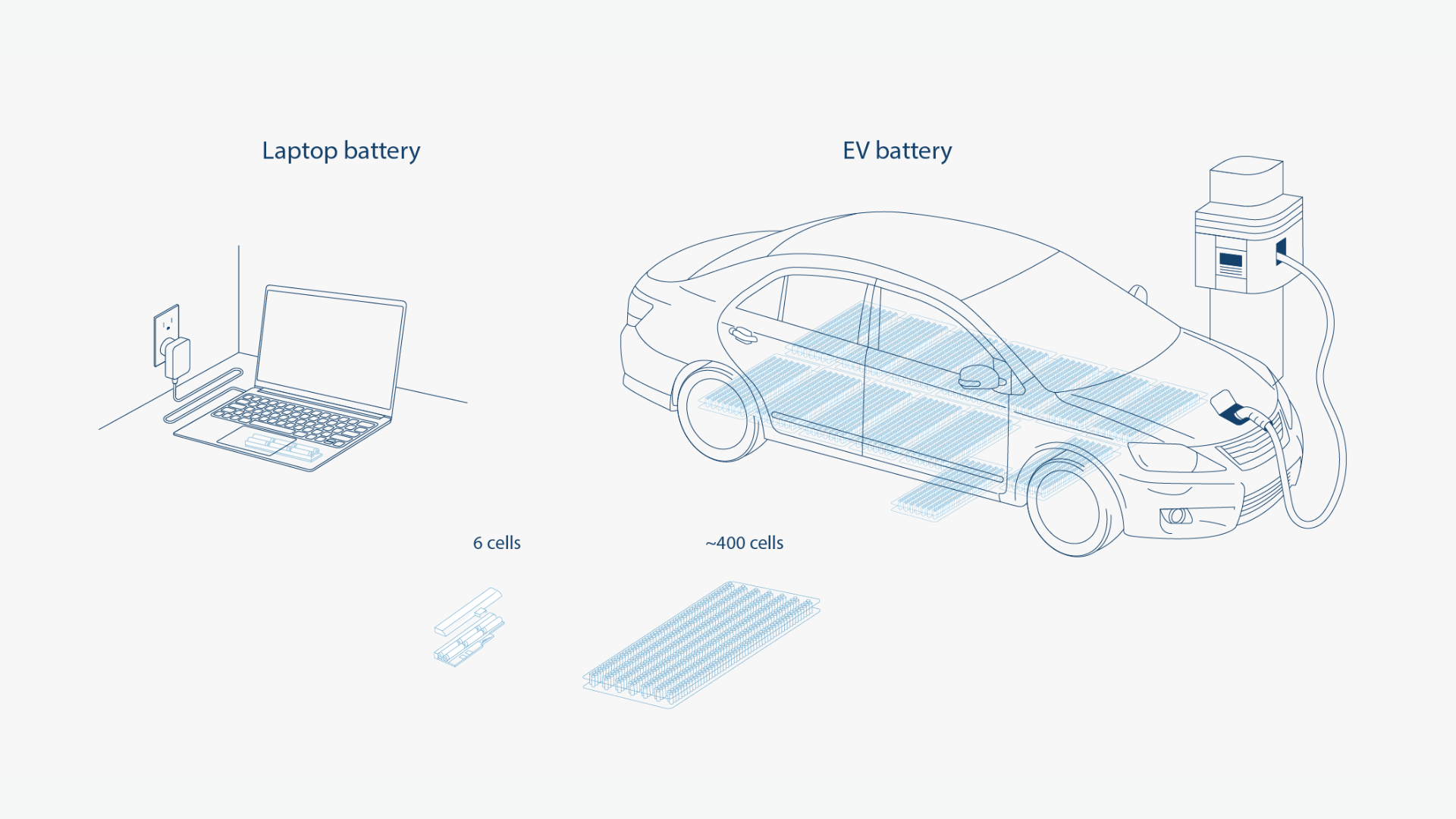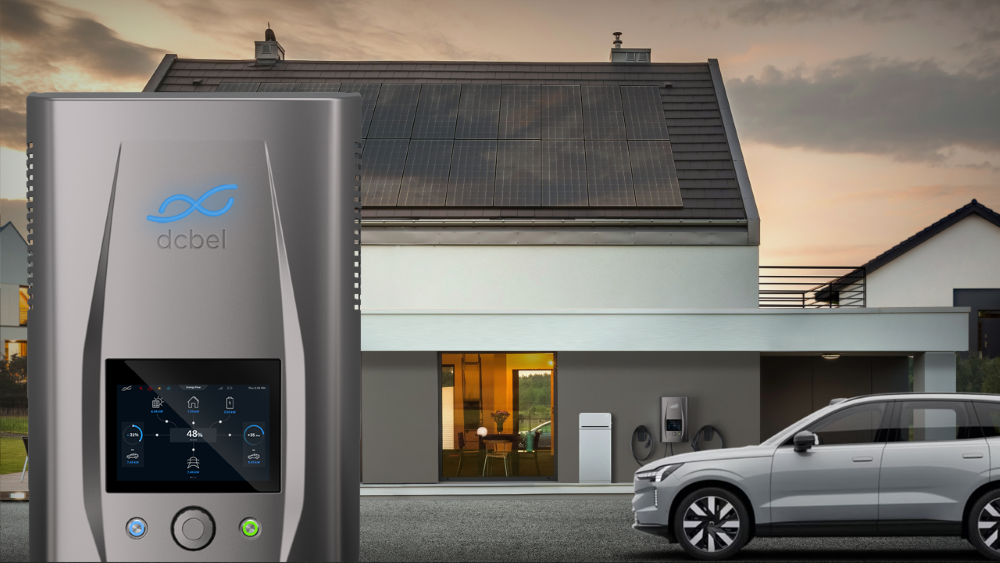As a centralized smart inverter, dcbel’s Home Energy Station is like Grand Central for your home’s clean energy. It is designed to be the only device in your renewable energy ecosystem that performs AC ⇄ DC power conversion – meaning the current flowing to and from all your home energy assets (like your solar panels and storage batteries) remains in its native format, only transformed when necessary by the Home Energy Station itself. Here’s why we designed our system like this – and how it can power your life today and well into the future.
AC vs DC in the home
For those who need a quick recap, electricity can be generated in two forms. Alternating current (AC) reverses direction at a set frequency (60 times per second in the US) and is used for long-distance transmission over power lines because it is cost-effective. Direct current (DC), in which electrons flow in one direction, is used by battery-powered devices and many electronics.
You’ll find examples of both AC and DC in a typical home. All the power outlets in a house supply AC energy. Any device needing DC uses a power converter called a rectifier to convert the energy from your home’s power outlets before it reaches the device.
This means that when you recharge your EV in your garage, household AC is getting converted into DC at some point.

I don’t have a DC charger at home; how is my vehicle getting recharged?
Even though you’ll commonly hear about AC and DC chargers, in reality AC battery charging is impossible. You can certainly send AC power to the vehicle (using a Level 2 charger, for example), but the AC ⇢ DC conversion process will always happen behind the scenes via a built-in rectifier (or onboard charger). If you were to use a DC charging station, that onboard charger can be bypassed and a stronger current can be sent to achieve faster charging.
The root of the rumor that claims DC charging is bad for EV batteries relates specifically to fast DC charging at Level 3 stations only.
Clean energy is a DC ecosystem
Solar power, battery storage and bidirectional EVs are the critical assets that can deliver home resilience and grid flexibility through renewable energy.
Solar panels generate DC energy, since the electrons knocked loose by sunlight flow in one direction. That unidirectional flow is also present in batteries, with electrons moving from the anode to the cathode.
Solar power, EVs and stationary batteries are DC by default, creating a compelling home energy ecosystem that can complement the everyday power grid. Solar energy can be stored inside the stationary battery and the EV battery, and those batteries could also feed energy to each other.
Many residential clean energy solutions isolate each component by installing DC ⇢ AC power converters (called inverters) alongside them, tying them to the home and the grid but not to each other.
If you wanted to store your rooftop solar energy in an EV battery, for example, having any power converters in between create obstacles which result in needless losses in efficiency. Centralized power conversion has clear advantages in terms of round-trip efficiency as well as control flexibility.

How do you calculate the efficiency of a system with multiple AC ⇄ DC conversion points?
The losses are exponential. Even if four high-performing inverters with an efficiency rating of 95% are used in the system, global efficiency would stand at 81% – meaning you would be losing 19% of the energy you started with.
- Solar inverter [DC ⇢ AC]
E = 0.95 Ei
- Stationary battery rectifier [AC ⇢ DC]
E = 0.95 × 0.95 Ei = 0.9 Ei - Stationary battery inverter [DC ⇢ AC]
E = 0.95 × 0.9 Ei = 0.86 Ei - Onboard EV charger [AC ⇢ DC]
E = 0.95 × 0.86 Ei = 0.81 Ei
How should EVs power the home?
Recent bidirectional EVs are being outfitted with increasingly large inverters to allow a degree of AC power export. This can be convenient for powering portable appliances on a road trip to a remote destination (known as vehicle-to-load, or V2L, power flow).
But moving forward, should the onboard inverter be used to power an entire home (V2H)?
At first glance, this approach would appear to maximize compatibility between the car, the home and the grid via a simple connection from the EV to the home’s service panel.
But as Laurent Schmitt, dcbel’s Head of Utilities & European Developments, discussed at a recent webinar hosted by the CHAdeMO association, there are several reasons why a DC approach is better suited to V2H.
Apart from the ecosystem integration issues described above, the biggest aspect to keep in mind when it comes to V2H relates to the standards that govern it. The ones that enable the offboard DC approach are in use today. Consider vehicles that use CHAdeMO connectors for DC charging (including the Nissan Leaf and Mitsubishi Outlander PHEV). CHAdeMO natively supports the communication between EV and bidirectional charger required to manage the bidirectional transfer of power.
When shopping for a V2H solution, bear in mind that blackout power is just one subset of all the possible vehicle-to-everything applications that homeowners can take advantage of. We’ll cover this in depth in a future article, but the main takeaway is you’ll need to evaluate home energy systems based on their functionality and interoperability across different brands of vehicles. dcbel r16 is designed to work with any bidirectional vehicle, able to power a home both during a blackout and at times when grid electricity is most expensive.
Ultimately, leaning on an EV’s built-in charger for increased home energy resilience places a cap efficiency as well as functionality. The car’s onboard charger is not a sophisticated inverter for the home, currently unable to integrate with multiple clean energy sources you may own, like solar panels and home batteries.
What about V2G?
By allowing EVs to discharge energy into the grid in response to peaks in demand, vehicle-to-grid (V2G) can contribute to energy sector decarbonization while replacing the need for expensive new grid infrastructure.
As a paper by Interstate Renewable Energy Council (IREC) explains, V2G could provide $1 billion in annual grid benefits in California alone if the state reaches its goal of 5 million EVs by 2030 and half of the EVs are V2G-enabled.
But before the US can harness V2G, states will need to incorporate technical standards into their interconnection rules. Central to this are grid codes, which regulate the behavior of a connected generator during system disturbances, typically governing things like voltage regulation, power factor limits and reactive power supply.
Once again, AC and DC configurations are on the table.
In the V2G-DC configuration, the power converter and smart functions reside in the charger, while in the AC configuration, those functions are handled by the vehicle.
According to IREC, existing standards including UL 1741 satisfactorily cover the safety and functionality of a V2G-DC setup, which resembles a typical stationary inverter from a certification and interconnection perspective. Simply put, this configuration is ready to roll.
In contrast, V2G-AC invokes the concept of mobile inverters. Since these are without precedent, equipment certification and technical standards for the onboard EV inverter will need to be developed to ensure safe grid operation, adding significant complexity to associated deployments. “It is absolutely critical for utilities that any converters or other devices interacting with the grid undergo rigorous testing as defined through grid codes,” said Schmitt.
This is partly because grid codes vary by location. Either the vehicle would need to manage complex, low latency communications with the EMS, or be certified in tandem with the AC charger.
UL 1741 SC, a supplement to the existing grid interconnection standard, is taking shape to address this gap. Because V2G-AC encroaches on vehicle functionality, SAE International is involved in this standardization process as well.
Bidirectional DC chargers provide peace of mind
While onboard EV chargers can be viewed as bidirectional in a V2L context, they don’t present a durable and dedicated solution for smart home energy and are hard to scale from a grid code compliancy perspective.
DC bidirectional chargers are a future-proof solution that can integrate cleanly with solar and storage largely because they minimize the number of AC ⇄ DC conversions.
They are also able to efficiently charge and discharge an EV while respecting the latest safety standards.
With next-generation energy management software (like Orchestrate OS built into the Home Energy Station), a DC bidirectional charger can be the one and only inverter on your wall thanks to over-the-air updates that keep the device current should you change vehicle, or as clean energy protocols are revised.


